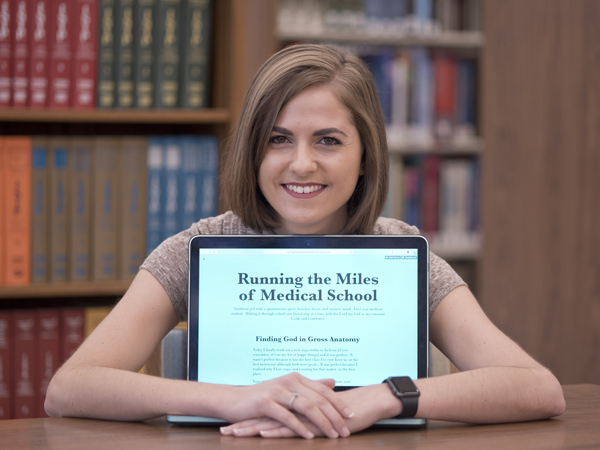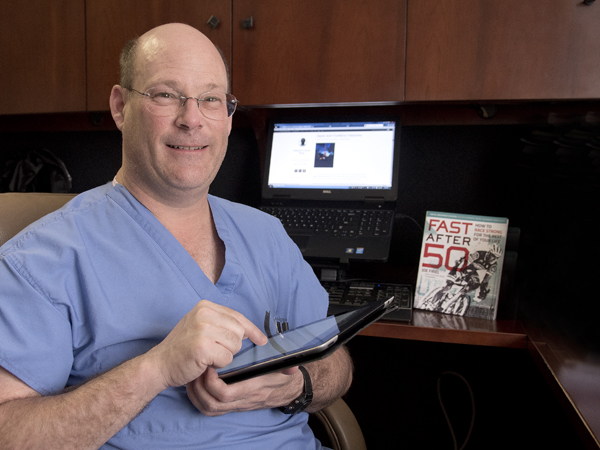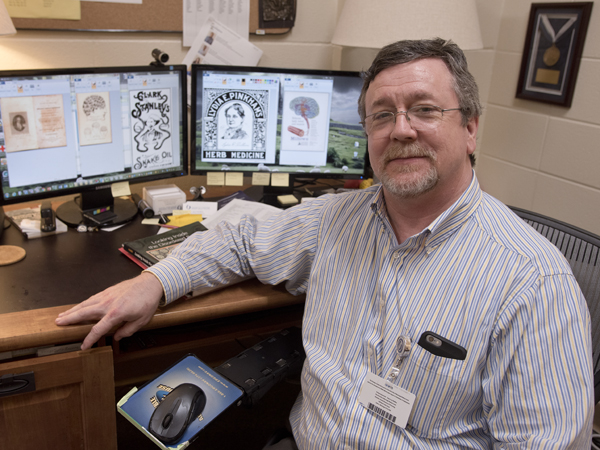Medical Center denizens enlarge, enrich blogosphere

Published in News Stories on April 21, 2016
Of the millions of people who pepper social media with blog posts each month or so, several teach at, learn at, or are in some way linked to UMMC.
While their commentary, case studies, personal reflections, self-improvement tips, etc., cover everything from finding nourishment in a black bean recipe to “finding God in Gross Anatomy,” their reasons for blogging bleed into each other's. They love writing, connecting with people and sharing ideas.
Though this is not a comprehensive list, here are several you may have come across, or want to check out.


Dacia Breeden, registered dietitian, UMMC Cancer Institute; blog: “Taste and See” (www.tasteandseebydaciard.com)
Breeden is a blogger who eats her words; she hopes others will do the same.
When she writes, she pictures a specific audience: Cancer patients she sees in the clinic. A photographer, as is her husband Jason Breeden, she posts photos of her creations as well.
“I started this mostly because my patients were asking about recipes and for more sources of information,” she said. “I thought this would be a good way to provide that, and a way to have a personal connection.
“Sometimes cancer patients have trouble eating regular food,” said Breeden, whose interest in oncology nutrition surfaced after her mother was diagnosed 20 years ago with leukemia.
“Some don't want to spend a lot of time in the kitchen when they don't feel well. Many have nausea, fatigue. They need something that nourishes them easily and quickly.”
To that end, she offers such concoctions as a “Healthy Colon Smoothie,” a potent brew of blueberries, bananas, yogurt, unsweetened coconut milk and honey.
But “Taste and See” is also for anyone who wants to eat healthy, she said, which is why she has also offered recipes for a veggie frittata, black beans with bell peppers and onions, a confection she calls chocolate-covered strawberry “footballs,” and more.
“I've had a lot of fun blogging,” said Breeden, who's working on a cookbook for cancer patients. “It's a really creative way to provide nutrition information.
“I make sure I taste-test every recipe, and I let my family taste it, too. My husband and two boys are the best critics, especially the boys. If they like it, it's thumbs up; I know it's a winner.”


Dr. Marino Bruce, science director of the Myrlie Evers-Williams Institute for the Elimination of Health Disparities, affiliate faculty member with the School of Medicine, and professor of sociology and criminal justice at Jackson State University; blog: “See Him” (www.marinobruce.com)
Like many bloggers, Bruce has a way with words, as the title of his blog suggests: He's also the founding director of the Evers-Williams Institute's Center for Health among Minority Males, or C-HMM: “See Him.”
“Him,” for the most part, refers to the African American male, but also to men in general. His blog is meant to put in context social and health-related issues affecting them, to help his readers consider those issues from a different perspective, “and maybe learn something they didn't think about before,” he said.
“For example, let's consider someone coming out of prison and how overwhelming that can be. One day you have a pretty rigid routine, the next day you have to figure all of it out. There are challenges, such as finding meaningful work.
“Also, the environment you live in has implications for your health, from elementary school all the way to the grave.”
To produce a blog about this, or anything else, he said, “you have to think. You write a sentence, and it's, 'wait a minute; where did that come from? How does that fit?' So, once you can move from emotional to the intellectual and maybe back to the emotional, you may even find out something about yourself you didn't know.”
To get a post started, Bruce usually waits for a catalyst, an item in the news, or a problem lately weighing on his mind. He has written about police shootings; the importance of Women's History Month for minority males; obesity and its health consequences for African American men, and more.
As a researcher, he has other outlets for his ideas. He recently completed a noted study of the link between social/psychological circumstances and chronic kidney disease in African Americans.
While rewarding, such work is not for the impatient, he said. “It can take up to a year-and-a- half to be published, or you may have to send your findings to other journals before you find a publisher.
“By the time you get it in print, the issue you've studied may be out of the community consciousness. If I have something to say, I want a more immediate vehicle for my thoughts: the blog.”
C-HMM write it.


Jade Cobern, M2; blog: “Running the Miles of Medical School” (runningthemilesofmedicalschool.tumblr.com)
Only in her second year of medical school, Cobern has already discovered a treatment for loneliness, forgetfulness, stress and frustration.
“Running the Miles of Medical School” is all that and a bag of virtual Ambien.
“The blog ties in two things I really love: medicine and running long distance,” she said. “There are parallels: In each case you have a goal in mind and you train hard to reach it.”
Cobern has always been interested in writing - “especially when you don't have a lot of people to talk to,” she said. That was her experience a few summers ago when she was far from home studying on a scholarship at Oxford University.
“I kept a travel log then, and I really liked writing down my experiences and feelings, then going back and reading it, reliving it in a way,” she said.
“When I was accepted as a medical student, I had heard so many people say that they forget what they did in medical school, because it went by so fast. I didn't want to forget it, even if it's stressful.”
It has been that. But the blog, and medical school in general, have been paths to self-discovery, she said. In one of her posts, she describes how she reconciled her religious faith with the principles of evolution, in “Finding God in Gross Anatomy.”
“Medical school has helped me learn a lot about myself, about the way I handle certain situations,” she said. “Surprisingly, it made me much stronger spiritually.
“But there was such frustration my first year. I needed to take a step back and look at the whole picture: Why am I not enjoying something I worked so hard for? And how can I make it more meaningful?”
An Arkansas native who also grew up in Hernando and Pontotoc, Cobern has found the blog to be a source of solace. “Being in Jackson has meant adjusting to seeing my family less, living in a new city. Making that adjustment has been easier by writing about it.”
She hopes she has helped others make the adjustment as well. “Several students have contacted me about a post my roommate shared last year; it was about finding the best way to keep yourself OK mentally. I believe in making a list of things that make you happy and keep doing them.”
This was the advice she had once heard from Dr. Steve Case, former associate dean of the School of Medicine, now retired.
“It's hard to study and easy to become frustrated when you're not doing the other things you love,” she said. “For me, it's running, watching movies, yoga, exploring places I've never been.”
During the years of medical school remaining to her, Cobern will find many more places to explore, and many more miles to run.


Dr. Larry Creswell, associate professor of surgery, cardiothoracic; blog: Athlete's Heart Blog (www.athletesheart.org)
Creswell, who has more than 18,000 followers on Twitter alone, also posts his blog on Facebook.
“One thing I've learned,” he said, “is that there are Twitter-only people and Facebook-only people.”
For eight years now, Creswell - heart surgeon, educator, triathlete - has been accommodating online detectives trying to crack the mysteries of high blood pressure, heart conditions and more through his “sports-related cardiology blog.”
“I believe these are people looking for reliable resources,” he said. “They need to get pointed in the right direction, to be encouraged to seek help for a problem. And people will give some extra credit to a fellow athlete; that's human nature.”
The blog is for everyone, he said, but he writes it mainly for “the educated, non-medical professional.”
“I had to learn, after feedback from readers, that the information can't have jargon, abbreviations and acronyms. I've gotten better over time.”
The Athlete's Heart Blog owes its origins to frequent questions about heart problems from Creswell's friends and other athletes.
“With a blog, you can reach a lot of people. And the information can be a resource for years to come; it doesn't go away.”
The only drawback, he said, is finding time to write it. “I have to make it work on my schedule. Sometimes I'll write in on a plane ride. Or on the patio. On a rainy day on vacation - if I'm watching the waves and the rain.
“It's a labor of love. The return is knowing you've been helpful somehow.”


Dr. Ian Paul, professor of psychiatry and human behavior, and director of medical student education; blog: Dr. Myomancer (drmyomancer.wordpress.com)
Two years ago, Paul was “stunned” when a colleague began evoking a character named Dr. Myomancer.
“She didn't know that was me; she didn't know that was my blog.” Which is good, in a way, he said. “I never wanted it to be tied to the Medical Center. I didn't know where it might go, and I hold some fairly strong opinions.”
Paul unveiled Dr. Myomancer about three years ago “to explain what scientists do, the advantages and limitations. To give people some idea of the pitfalls.”
His wife Julie edits his blog, which needs it, he said. “One day Julie said that for my birthday she's going to give me a huge box of commas.”
Otherwise, the words, and much of the punctuation, are his, as is the title. “Myomancer” refers to the art of prophecy based on the rodent lifestyle. “It seemed particularly appropriate for me,” Paul said, “since I've spent my career studying rodent behavior.”
The blog's name may be a bit whimsical, but its author's motivations are not.
“I've always enjoyed writing,” Paul said. “I've always admired people like [the late paleontologist] Stephen J. Gould and [astrophysicist] Neil deGrasse Tyson, who can make science accessible.”
Similarly, Paul wants to “make psychiatry accessible - to show that it does have a biological basis and treatment is a good thing.”
In turn, blogging is good thing for him, a way to 1. organize his thoughts 2. experience the satisfaction of “taking a complex problem and explaining it so that more people can understand it;” 3. “blow off steam.”
One of his best-read entries, though, was less about science and more about a scientist. Written almost three years ago, it was a eulogy for Dr. William Woolverton, who served as vice chair for research in the Department of Psychiatry and Human Behavior.
It began this way: Bill Woolverton was a 6 foot, 5 inch native of Alabama with a rich, soft Deep Southern drawl, and a deep love of Bluegrass music. He also possessed a far-ranging and inquisitive mind. He was a prolific scientist, a great mentor, and my colleague and friend for the past twenty years.


Dr. Lisa Stempak, assistant professor of pathology, laboratory at the Jackson Medical Mall; certified microbiologist; blog (as a contributor): Lablogatory (labmedicineblog.com)
Lablogatory's “team of mad scientist writers” (in the blog's own tongue-in-cheek words), showcases a variety of accomplished and, to be fair, sane experts, including one of UMMC's own.
For her part, Stempak posts one case per month, as in a case study of “A 33-year-old Female with Abdominal Pain,” or “A 39-year-old Male with Headaches and Fatigue.”
Brought to you by the American Society for Clinical Pathology, Lablogatory first came to Stempak's attention some months ago, when she noted that its contributors included Dr. Christi Wojewoda, whom she met from pathology residency training at Case Western Reserve University.
“It's a nice way to share information with your colleagues in an easy-to-read format. There's not the same stress of trying to publish a paper,” Stempak said.
It's also a nice way to engage residents during their time in the lab. As an educator, Stempak has parlayed the blog into an assignment for pathology residents during their microbiology rotations. At least two residents, Dr. Brooke Sims and Dr. Srinivasa Chekuri, have collaborated with her on separate case-study posts so far.
“Everyone knows the common stuff,” Stempak said. “We try to share the more interesting or rare cases.”
Apparently, her fellow bloggers return the favor. “You can read a blog in three to five minutes and gain a piece of knowledge you might have forgotten, or learn something entirely new,” Stempak said.
“It's my continuing education for the day.”
If such matters as electrophoresis and persistent scalp rashes aren't your cup of tea, you may want to give Lablogatory a pass. But, for medical lab professionals and students, etc., it could be pure ambrosia.


